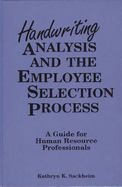
Handwriting Analysis and the Employee Selection Process
ISBN-10: 0899304419
ISBN-13: 9780899304410
$85.00
Book Specs
Trade Cloth
Praeger
Published on
Oct 5, 1990
Edition
st Edition
Dimensions
6.14x0.56x9.21 Inches
Weight
1.13 Pounds
About the Book
The first graphology book written specifically for human resources professionals, this volume is designed to help those involved in the selection of new employees find out how handwriting analysis can help them learn more about the people they plan to hire and promote. As the author notes at the outset, handwriting analysis is beginning to enjoy widespread acceptance in the U.S. as a valuable adjunct to other pre-employment tests. Sackheim suggests how managers can best work with a professional graphologist, shows how to find a consultant with the proper credentials, and demonstrates how to evaluate the various traits revealed by handwriting analysis according to how they affect business situations. Numerous case studies and hundreds of handwriting samples are included to illustrate points made in the text.
Sackheim begins by placing graphology into historical perspective, tracing its development from the time of Aristotle to the present. Part I covers the process of graphology and moves from a general discussion of handwriting through such specifics as slant, rhythm, pressure, and size; spacing, writing speed, and style; and straight lines, circle letters, and i-dots. The second section presents case studies of sales people, managers, presidents, and other jobs and demonstrates how handwriting analysis can be an effective tool in evaluating candidates for various types of positions. In the third section, Sackheim provides the first complete survey of the graphology literature ever published. Her review encompasses virtually every study written in English since 1919 as well as over 50 articles in psychological journals. The final chapter addresses the legal issues involved and discusses discrimination laws and the right to privacy, U.S. Supreme Court decisions, and Equal Employment Opportunity Commission requirements. With the background provided here, human resource professionals will be able to add handwriting analysis to the tools they are already using for the selection and evaluation of employment candidates throughout the organization.
